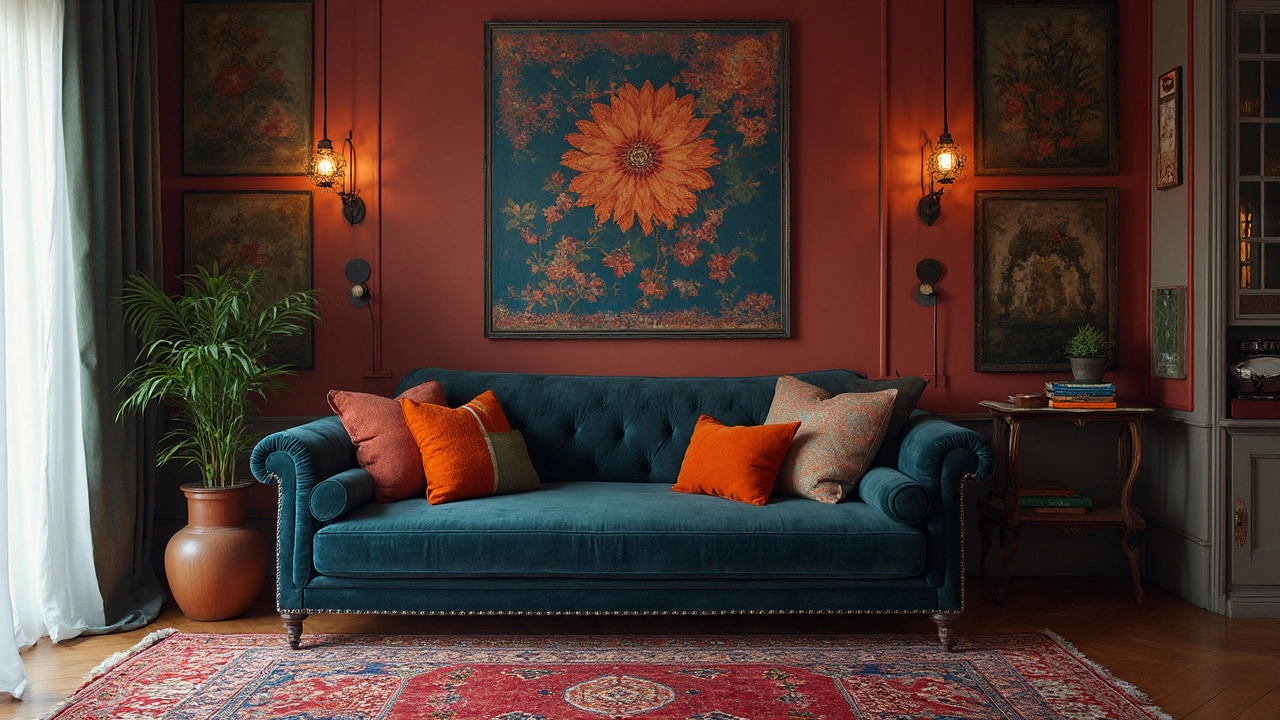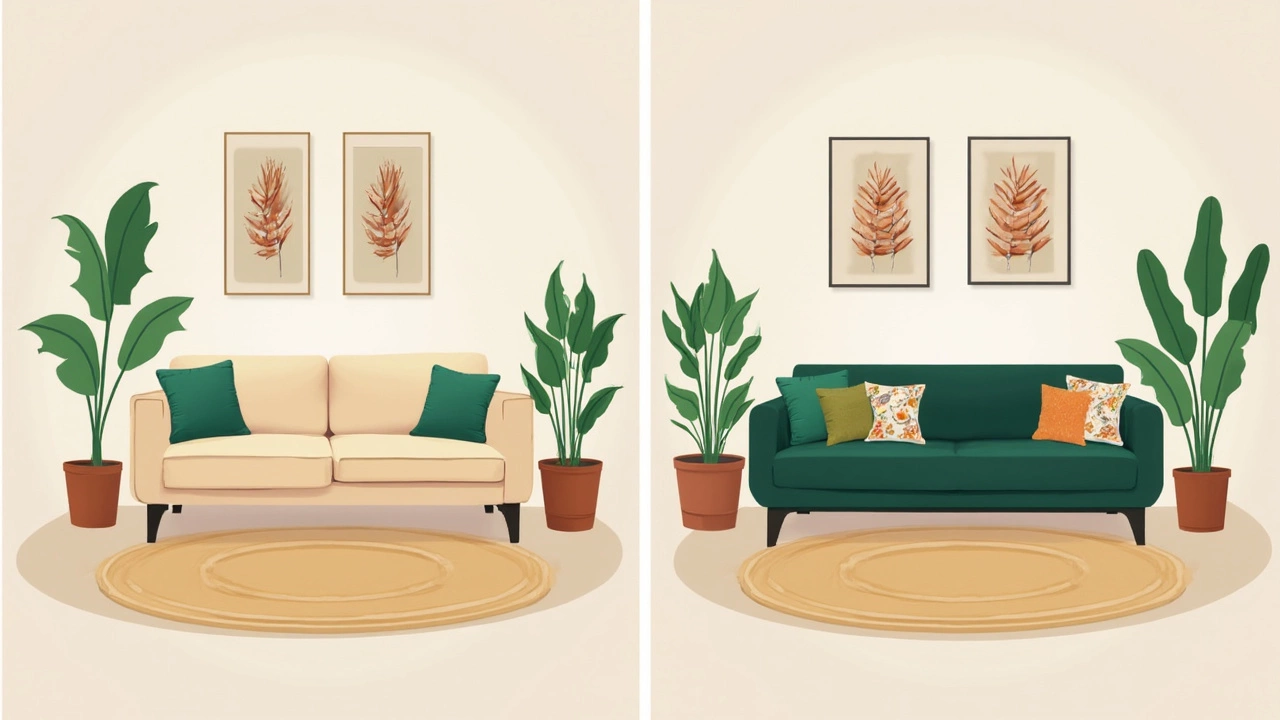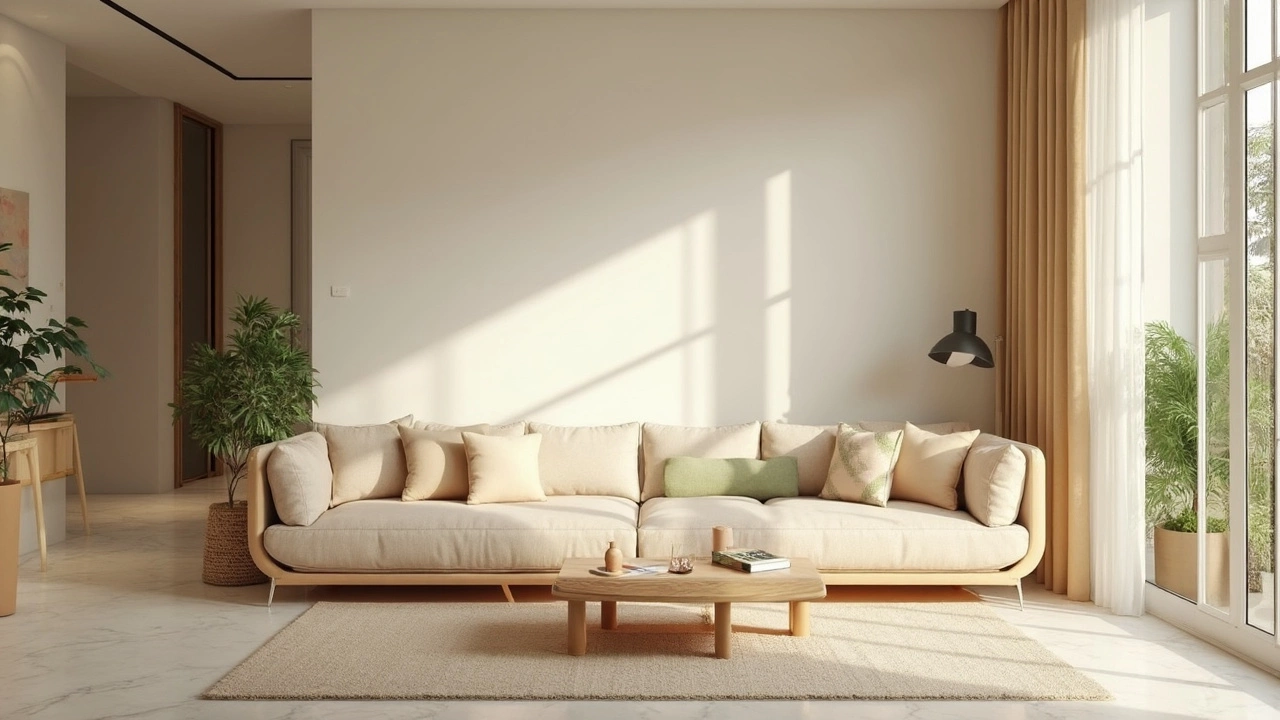Ever noticed how some rooms just feel way more spacious, even if they're tight on square footage? Turns out, the color of your sofa pulls a lot of weight in that optical illusion. If you pick the wrong shade, the whole space can seem like it's closing in. But pick the right one, and suddenly it breathes.
If you want your room to look bigger, go straight for lighter colors. Sofas in shades like off-white, pale gray, or soft beige tend to melt into the background, making walls seem farther apart. It's the same reason landlords always paint apartments in eggshell—light bounces around, creating a natural sense of airiness.
Dark colors, on the other hand, absorb more light and can make your sofa look bulky, eating up precious visual space. If you love a deep navy or charcoal sofa, keep it balanced with lots of light throws or pillows, and make sure the rest of the room sticks to light tones.
- The Science of Color and Space
- Best Sofa Colors for a Bigger Look
- Pairing Your Sofa with Room Decor
- Mistakes That Make Rooms Look Smaller
- Pro Tips for Small Room Sofa Styling
The Science of Color and Space
Here’s something wild: our eyes and brains play lots of tricks on us in small rooms. Color isn’t just about personal taste—it really messes with how big or small we think a place is. Lighter colors, especially sofa color options like cream, light gray, or even pale pastels, reflect more light and basically blur the edges between furniture and walls. This makes the whole place seem taller, wider, and way less cramped.
There’s actual science behind it. Lighter hues scatter light in a room, which ramps up the brightness and tricks your brain into feeling like there’s more open air. A survey by the American Institute of Architects back in 2022 showed that 61% of interior designers pick light-colored sofa sets for smaller living rooms versus only 28% choosing darker ones.
- Light colors = Light reflection, airy vibes, and space expansion.
- Dark or bold colors = Absorb light, make things feel closer and heavier.
It’s not just about the color of the sofa itself, either. If the couch is just a couple of shades away from your wall color, that smooth transition makes everything blend. If you go with a heavy contrast—like a dark sofa against white walls—it can split the room into chunks, which gets claustrophobic fast.
One more thing: shiny or textured fabrics also impact perception. Soft, matte fabrics in pale tones spread light gently, while glossy materials like leather can bounce light around even more. If you’re working with a tiny living space, understanding these tricks of color and texture is key to making every square foot count.
Best Sofa Colors for a Bigger Look
The magic trick here really is in the color palette you choose for your sofa color. Lighter shades usually do all the heavy lifting when it comes to making a space feel open and airy. These colors reflect way more light, helping walls and floors blend together, which fools your eyes into thinking your small space is bigger than it actually is.
Top picks for a sofa that maximizes room size include:
- Soft White or Off-White: This one’s a no-brainer. White makes everything look clean and spacious. But if you’ve got pets or kids, consider off-white instead. It hides stains better but still keeps your room feeling light.
- Pale Gray: Super modern and doesn’t get dirty as easily as pure white. Pale gray looks trendy and works with almost any interior design vibe.
- Beige and Taupe: These classics quietly do their job. Beige and taupe blend with most wall colors and don’t make the sofa pop out, which helps your eye move freely around the room.
- Pastel Blue or Green: If you’re bored of neutrals, pastels are your friend. Soft shades of blue or green are still calming and easy on the eye, but they add a bit of personality without crowding the area.
It’s not just about picking one of these shades and calling it a day, though. Pay attention to your fabric, too. Shiny or textured fabrics can actually bounce light and make things feel even bigger. Microfiber and linens in light tones work especially well for this.
To get a sense of how much light color matters, check out this quick stat—according to a 2023 home decor survey, 61% of professional designers pick light gray, beige, or white sofas for small spaces, simply because these colors make rooms look bigger and brighter.
| Sofa Color | Light Reflection | Impact on Room Size |
|---|---|---|
| White/Off-White | High | Makes room look much bigger |
| Pale Gray | High | Opens up space |
| Beige/Taupe | Medium-High | Softens borders, still enlarges space |
| Dark Blue/Black | Low | Makes room look smaller |
Skip strong, dark colors like chocolate brown, deep green, or burgundy if your space is already tight. They might look cozy, but they’ll shrink your room, fast. The goal? Blend instead of boldly standing out.

Pairing Your Sofa with Room Decor
Getting your sofa color right is only half the battle—you’ve got to tie it in with the rest of the room so it doesn’t feel out of place or make the space feel crowded. The trick is balance. If your sofa's a light shade, keep the walls and big furniture in a similar tone. Your eyes flow across the room easier, and nothing feels like it’s breaking up the space.
Accent pieces, like throw pillows or small rugs, are where you can play with bolder colors or patterns. Just be careful not to go overboard. For a room that feels bigger, limit the number of standout colors to two or three. If you’ve got a beige sofa, maybe add soft blue or muted green cushions and a white coffee table.
A great move is to use mirrors or shiny decor. They bounce light and make your small spaces look much larger. Hide clutter, too—nothing shrinks a room like piles of books or scattered shoes. Go for furniture with exposed legs, like mid-century style sofas, since they let you see more floor, adding to the open feel.
- Match sofa and wall colors for a blended, spacious look.
- Use accent pieces in similar tones for a pulled-together vibe.
- Limit bold or dark colors to small decor items—think a single throw or one statement vase.
- Keep window treatments light and airy to let natural light do the work.
Lighting matters, too. A room with just one ceiling light can end up with shadows, making it feel smaller. Layer lamps and wall sconces for a brighter, roomier space. You can really see the difference when you compare how much lighter a room feels with smarter decor choices:
| Decor Choice | Room Perception |
|---|---|
| Light sofa & matching walls | Looks bigger, more open |
| Dark sofa & bold accent walls | Feels closed in, heavy |
It all comes down to blending your sofa sets with the rest of your decor for a space that doesn’t just look bigger—it actually feels like it lives bigger, too.
Mistakes That Make Rooms Look Smaller
It's actually pretty easy to make a small space look even tinier—especially if you don’t pay attention to the kind of sofa color you pick or how you style the whole setup. Some mistakes are classic, but people keep making them.
- Going Too Dark: Dark sofa sets can feel cozy, sure, but jam one into a smaller room and it eats up all that airiness. It’s like the room gets sucked in around it.
- Heavy Patterns: Loud patterns and busy prints on the sofa (or even the rest of your furniture) can make a space look cluttered. The eye gets stuck, and everything just feels more jam-packed.
- Matching Walls and Sofa: Picking a sofa color that’s super similar but not quite the same as the wall color creates weird shadows and makes everything feel squished. Either blend seamlessly with very close shades or pick clear contrasts.
- Chunky Furniture: Large, bulky sofa arms and overstuffed cushions take up a ton of visual room. Go for sleeker silhouettes if you want your area to feel open.
- Poor Lighting: No matter how perfect your interior design is, if the lighting is bad, your sofa (and the entire room) just looks heavier and smaller.
- Pushing Everything Against the Wall: Weirdly enough, putting the sofa flush against the wall doesn’t always help. Sometimes leaving a few inches of breathing room makes the layout feel less cramped.
Want some real numbers? A study from Houzz found that 67% of homeowners regret picking oversized sofas for small spaces—they ended up swapping for something lighter and brighter within two years. That’s a lot of wasted cash.
The trick is thinking about every choice—color, size, and decor—as working together. Avoiding these common mistakes gets you a room that feels bigger, lighter, and way more comfortable.

Pro Tips for Small Room Sofa Styling
Ready to make your small space feel bigger without knocking down a single wall? The secret is in how you style your sofa color and position your furniture. Let’s cut through the clutter and get to the hacks that actually work for a tighter spot.
- Go for legs, not skirts: Sofas that show their legs make the room look open underneath. Those with full skirts or bulky bases feel heavier and eat up floor space visually.
- Match your sofa to the walls: Choose a sofa color that’s close to your wall color. This trick creates no hard boundaries and makes everything blend, giving the illusion of a bigger room.
- Pick multipurpose pieces: If you’re eyeing that L-shaped giant, skip it. A more streamlined, compact design with a small footprint leaves plenty of space to move around. Bonus if it has built-in storage.
- Light is your best friend: Place your sofa sets near windows or use mirrors behind the sofa to bounce more natural light around. Bright rooms always feel more generous.
- Edit your throw pillows: Don’t overdo it. Too many pillows not only hide your sofa, they make it and the whole space look cramped. Two to three well-placed throws are plenty.
Here’s a quick snapshot on how color choices and sofa leg style affect perceived space (based on a popular 2023 interior design survey):
| Feature | Percent of Rooms Rated As “Spacious” |
|---|---|
| Light-colored Sofa | 84% |
| Sofa with Visible Legs | 78% |
| Dark-Colored Sofa | 39% |
| Sofa with Skirt/Base | 28% |
Don’t forget to keep the area around your sofa sets tidy and uncluttered. Less mess means more visible floor and more floor always equals more room—at least, to your eyes.

